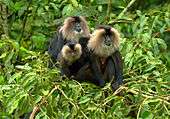New Amarambalam Reserved Forest
| New Amarambalam Reserved Forest | |
|---|---|
|
Columba elphinstonii photographed near Munnar | |
| Location | Kerala, India |
| Nearest city | Amarambalam, Nilambur |
| Coordinates | 11°14′0″N 76°11′0″E / 11.23333°N 76.18333°ECoordinates: 11°14′0″N 76°11′0″E / 11.23333°N 76.18333°E |
| Area | 26,572 hectares (65,661 acres) |
| Established | 2003[1] |
New Amarambalam Reserved Forest is a protected area in the Western Ghats, situated in the Kerala state in South India.
.jpg)
Geography
Comprising an area of 26,572 hectares (65,661 acres), the Amarambalam Reserve Forest is one of the largest reserve forests of Kerala in South India. Since it shows very high altitudinal gradation from 40 metres (131 ft) to 2,554 metres (8,379 ft), the protected area is coupled with high rainfall and thick forest cover. Amarambalam continues with the Silent Valley National Park, and also forms a part of the Nilgiri Biosphere Reserve.[1]
Bird sanctuary
The Indian Bird Conservation Network (IBCN) has identified 212 species of birds from the Nilambur and Amarambalam forests. Amarambalam is classified as an Important Bird Area (IBS) of the Western Ghats Endemic Bird Area where 16 restricted range species (RRS) have been identified; eight species have been sighted in Amarambalam. Beside the RRS's, there are one critically endangered and two vulnerable species. In 2001 BirdLife International has also identified 52 near threatened species (NTS) of India. Three of the NTS bird species are found in the IBA, but more are likely to be found once detailed studies are conducted. Classified by BirdLife International, Amarambalam Reserve Forest lies in the Indian Peninsula Tropical Moist Forest (Biome-10): 15 bird species have been identified as typical biome assemblage, 12 species are found in this IBA.[1] In 2003, Professor PO Nameer, Kerala Agricultural University,[2] reported to have seen 11 species of woodpeckers, 11 species of flycatchers, nine species of babblers, seven species of bulbuls, and three species of barbets. As of 2004, there were populations of 10 IBA trigger species ranging from critically endangered/vulnerable to least concern according to IUCN categorisation and A1 to A3 according to IBA, namely Lesser adjutant (Leptoptilos javanicus), White-rumped vulture (Gyps bengalensis), Nilgiri wood-pigeon (Columba elphinstonii), Malabar parakeet (Psittacula columboides), Malabar grey-hornbill (Ocyceros griseus), White-bellied treepie (Dendrocitta leucogastra), Grey-headed bulbul (Pycnonotus priocephalus), Rufous babbler (Turdoides subrufus), White-bellied blue-flycatcher (Cyornis pallipes) and Crimson-backed sunbird (Nectarinia minima). The bird community showed high evenness. Maximum species richness was obtained during November and highest diversity index was recorded during April.[1]
Endemic fauna of the Western Ghats
As of 2000, Amarambalam comprises almost all mammals found in the Western Ghats: 25 mammals, including the endemic and threatened Lion-tailed macaque (Macaca silenus) and Nilgiri tahr (Hemitragus hylocrius).[1]
Publications
- BirdLife International: Threatened Birds of Asia. The BirdLife International Red Data Book. BirdLife International, Cambridge, U.K., 2001.
- Sharma, J. K., Ramachandran, K. K., Nair. K. K. N., Mathew, G., Mohandas, K., Jayson, E.A. and Nair, P. V.: Studies on the Biodiversity of New Amarambalam Reserved Forest of Nilgiri Biosphere Reserve. In: Biosphere Reserves in India and their Management. Proceedings of the Review Meeting: Biosphere and their Management, 8-11 September 2000, Peechi, Kerala.
- Nameer, P.O.: Birds of Nilambur Forest Division - a survey report. NEST & Kerala Forest Department, 1993.
- Saneesh, C.S.: New Amarambalam Valley: an IBA of Kerala . MISTNET , 2009.
References
- 1 2 3 4 5 "BirdLife International (2016) Important Bird and Biodiversity Area factsheet: Amarambalam Reserved Forest - Nilambur". BirdLife International. Retrieved 2016-01-03.
- ↑ "Nameer PO, Associate Professor & Head". Kerala Agricultural University. Retrieved 2016-01-04.
External links
| Wikimedia Commons has media related to New Amarambalam Reserved Forest. |
.jpg)

